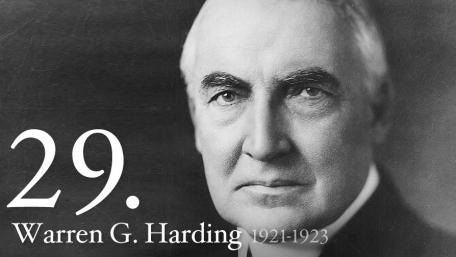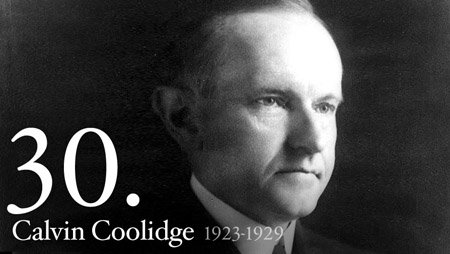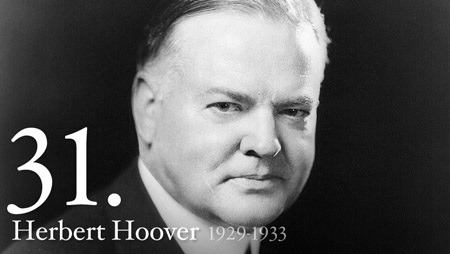American Presidents Between the Two World Wars
by J.D. Arden, M.L.I.S. candidate, Reference Services Research Intern, Center for Jewish History

On this Presidents’ Day, in the wake of one of the most heated political campaigns of recent memory, it is interesting to look back at how the interests of American Jews figured into the presidential scene of three presidents—Warren G. Harding, Calvin Coolidge and Herbert Hoover—nearly 100 years ago. The State of the Union, under President Obama, continues this history of give-and-take with regard to issues of immigration, integration, identity, discrimination and rhetoric.
Following the cheers at the appointment of Louis D. Brandeis (1916-1939) in 1916 by President Wilson, the Jewish community of the U.S. entered a troubled period with little cause for cheer. In 1915, the Klu Klux Klan had been reorganized into a threatening social force. Colleges and universities (including Harvard, for one example) began to introduce formalized quota laws, limiting Jewish student enrollment and effectively banning Jews from faculty or administration positions.
In 1921, Republican President Warren G. Harding was elected on a platform of a “return to normalcy” following World War I. Despite scattered support from American Jews—including entertainer Al Jolson (1886-1950)—Harding received only 43% of the Jewish vote. This was the same Harding who as a senator had voted against the very first appointment of a Jewish American, Judge Louis Brandeis, to the Supreme Court five years earlier.

(The images of presidents found in this blog post are from the White House slideshow, “Our Presidents.”)
Almost immediately following his election, President Harding signed the “Emergency Quota Act,” drastically limiting Jewish immigration from Eastern and Southern Europe at a time when anti-Semitism was on the rise internationally. In fact, some senators felt that the immigration quota—which was set at 3% of the 1910 census of each ethnic group—should have been even lower. The motives of anti-Semitism were evident in the contrast between the higher quotas for North-Western European countries and the drastically smaller (and less impoverished) Jewish populations.
Despite the anti-Jewish feeling in Europe and America of the time, President Harding did make a small reconciliatory gesture to the Jewish community. He officially welcomed two visitors from Germany in 1921: namely, Chaim Weizmann (1874-1952) on a fundraising campaign for the Zionist organization Keren Haseyod, and Albert Einstein (1879-1955) – who was a recent recipient of the Nobel Prize for Physics. Due to his Jewish identity, it would not be until years later that Einstein could join the faculty of Princeton University.
One of the most troubling personal relationships of President Harding was with automobile manufacturer and notorious anti-Semite, Henry Ford. Their political alliance benefited Ford’s interest in keeping a low minimum wage and weakening labor unions. Even more unsettling than Ford’s business philosophy, however, was the rabid anti-Semitism he endorsed through the pages of the newspaper he sponsored—The Dearborn Independent—as well as his book, The International Jew. (Reportedly, Adolf Hitler owned a well-worn copy of this book, and a portrait of Henry Ford.)
The stream of Henry Ford’s hateful articles accusing Jews of controlling the economy, plotting to corrupt American culture via Hollywood movies and various other conspiracy theories eventually provoked lawyer and activist Aaron Sapiro (1884-1959) to bring a lawsuit against Ford for defamation. Ford was forced to write an apology letter. Before his death in 1947, Ford is reported to have claimed that his signature was forged—remaining unrepentant until his last breath.
President Harding died in 1923 while still in office, and Republican VP Calvin Coolidge assumed the Presidency. He subsequently won re-election in 1924. American Jews, still unhappy with immigration restrictions, contributed only 27% of the re-election vote for Coolidge.

Following the election, the Immigration Act of 1924 further reduced the chances of Jews in Europe to reach America’s shores. In response to these restrictions, the American Jewish Committee (AJC) was founded to the aid Jews worldwide. The principal founder, Louis B. Marshall (1856–1929) was the AJC President from 1912-1929. He was also instrumental in the Aaron Sapiro case against Henry Ford cited above. This was a significant moment in American history: when the implicit or even open tolerance for public and political anti-Semitism began to be overcome.
Among other success stories of American-born Jews of the time were Adolph Simon Ochs (1858-1935) and, later, Arthur Hays Sulzberger (1891-1968), under whose leadership in the 1920s and 1930s the New York Times rose to the level and authority that we know today, increasing readership exponentially.
In 1925, President Coolidge gave a noteworthy address at the cornerstone ceremony of the Washington Jewish Community Center. He remarked:
The Jewish faith is predominantly the faith of liberty… America has been a new land of promise to this long-persecuted race… Every inheritance of the Jewish people, every teaching of their secular history and religious experience draws them powerfully to the side of charity, liberty, and progress (Dalin & Kolatch, The Presidents of the United States and the Jews).
For these words, Louis Marshall wrote a thank-you note to the President and was respectfully sent a reply.

Calvin Coolidge did not seek re-election, and in 1929 another Republican, Herbert Hoover, was inaugurated as the 31st President of the U.S. Although he did not receive much of the Jewish vote, he did have many noteworthy Jewish supporters. Among them were Lewis Strauss, Julius Rosenwald, Harry Guggenheim, Felix Warburg, Herbert Straus and Louis Marshall. And, although the ports of the United States remained almost totally closed to any significant immigration of Jews abroad, several American Jews gained appointments to significant positions within the government of the U.S. at the time. Benjamin Cardozo (1870-1938) was appointed to the Supreme Court. Rabbi Abba Hillel Silver (1892-1963) was appointed to the government committee for unemployment relief.
These years were significant in tracing the setbacks, gains, optimism and hardship of American Jews after the turn of the century. However, the greatest test of the American people—and of an American president in the midst of unemployment and war—was yet to come. Our next post in this blog series on U.S. presidents and the Jews will feature the following election, which brought a flood of Jewish support for F.D.R.
—–
For more information on the individuals or institutions mentioned
above, please review the following links to our collections:
“Edited version of a series of articles first appearing in the
Dearborn independent, 1920.” This book is part of the Anti-Semitic
Literature collection.
Henry Ford’s retraction and apology to the Jews : correspondence
between Henry Ford, Louis Marshall and Herman Bernstein, settlement of Aaron Sapiro’s and Herman Bernstein’s libel suits.
The price of liberty : a history of the American Jewish Committee
Iphigene : my life and the New York Times : the memoirs of Iphigene
Ochs Sulzberger as written by Susan W. Dryfoos Iphigene Ochs
Sulzberger.
—–
Bibliography of sources consulted for this blog post:
Dalin, David G. & Kolatch, A. (2000). The Presidents of the United
States and the Jews. Middle Village, NY: Jonathan David Publishers,
Inc.
– available in the open-access Reading Room reference section at the Center for Jewish History.
The linked sources for this blog post are findable through the online “Search the Collections” catalog; click here.

